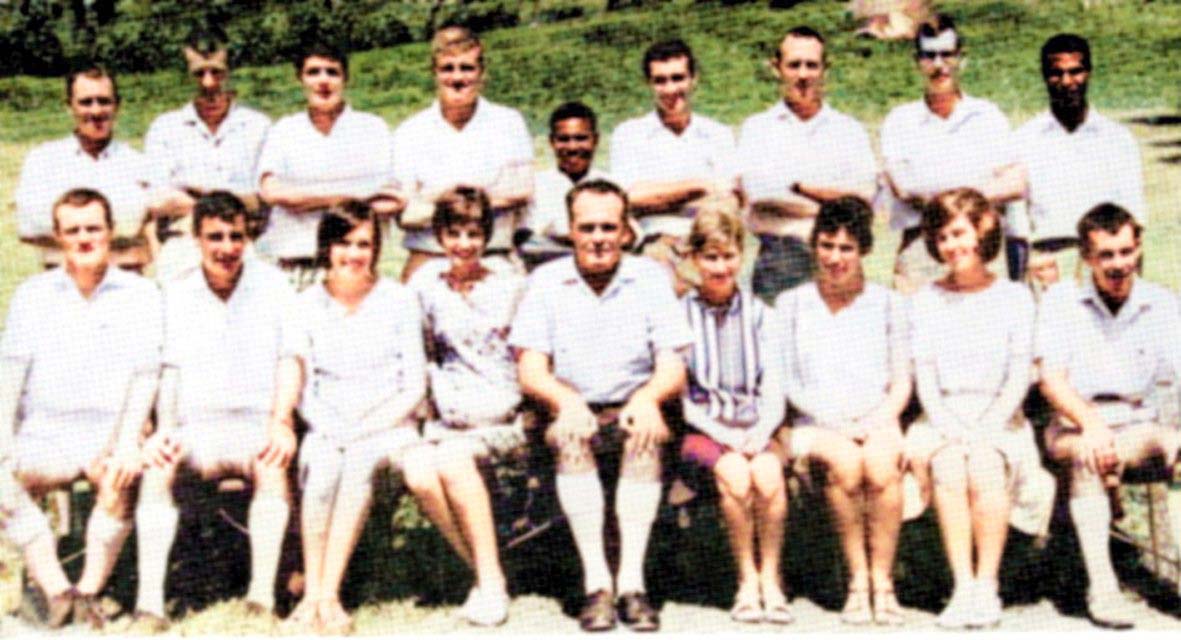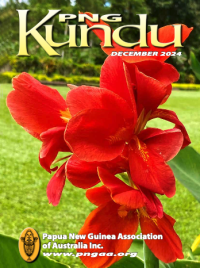Our Time in PNG: and How I Became a Historian There
Ian Howie-Willis
From the time I was five years old, I wanted to go to Papua New Guinea. That was in 1943, the year the Australian Army recaptured Lae, Salamaua and Finschhafen from the Japanese. At my Methodist church in Melbourne, we sometimes saw films about the PNG mission fields. The films told me that Fuzzy-Wuzzies lived in PNG, and their souls would be saved if I put pennies in the mission box. Soul-saving was a mystery, but I did know I wanted to go there.
My chance came in 1964, when I was teaching in a lonely little one-room, one-teacher school in Warrambeen, out along the Geelong-Skipton road in Western Victoria. Responding to a newspaper advertisement, I applied for secondment to the PNG Department of Education, was accepted and joined about 60 other new Australian secondees in Port Moresby in early January 1965.
After a two-week orientation course at the Ela Beach Primary School, we were posted to schools all over PNG. I was fortunate to be sent to Brandi High School, on the coast 11 kilometres east of Wewak in the East Sepik.
I wanted to be at Brandi because my younger brother, David, was the Department of Agriculture, Stock and Fisheries didiman at Angoram, on the big river only 70 kilometres south-east of Brandi.
Margaret and our infant daughter, Rosemary, joined me at the end of the month. Our second child, Tony, was born in the Wewak Hospital at Boram that August. Our third, Katie, arrived in the ANGAU Memorial Hospital in Lae in early 1969. We accordingly produced one Aussie, one Sepik and one Morobean.
Brandi High School was a great adventure for Margaret and me. She joined the Brandi staff in our second year there, 1966, after our headmaster, the late great Jeff Keast, talked her into it. Needing a Form 1 English–Social Studies teacher, he obligingly arranged child-minding for us and juggled the timetable so she could teach all her classes before lunch, and then spend the afternoons with Tony, who was only five months old.
I could easily write a book about our three years at Brandi, but I’ll limit myself now to two short anecdotes. The first is about Margaret’s new lacey, black bra, which disappeared from our clothesline. A few weeks after this we were attending a singsing at Maur village, 500 metres east of the school beyond the Brandi River. As the female dancers trooped onto the dancing ground, Margaret exclaimed: ‘That’s my missing bra!’ pointing to one well-endowed woman. Perched on the tips of the woman’s pendulous breasts was a wholly inadequate lacey, black bra. ‘Do you want it back?’ asked Deirdre, Margaret’s best friend on the Brandi staff. ‘No,’ replied Margaret, ‘her need is far greater than mine!’
The second story concerns the war museum I set up in a spare classroom. (The museum is still extant 59 years later.) As the Brandi history teacher, I thought that such a collection would be a good idea. So much detritus of the recent war was littering the jungle around the school that preserving some of it would show how Brandi had been caught up in the fighting. We soon had rifles, bayonets, helmets, pistols, the peculiar two-toed boots worn by Japanese marines, assorted bomb and shell casings, an air raid siren, an anti-aircraft gun and a searchlight. We even found a couple of Japanese skeletons at the end of a tunnel, but they didn’t go into the museum because the District Commissioner, Ted Hicks, took responsibility for them.
The most amazing exhibit was a set of six ice skates. An excavator digging a trench for a water pipeline across the school grounds threw them up from a depth of about 1.5 metres. Though rusty, they were clearly ice-skating blades. How did they get there—three degrees below the equator with the nearest ice-skating rink 3,455 kilometres away in Sydney?
In January 1968, we moved to Lae so I could teach English at the new Institute of Higher Technical Education, which was being relocated to Lae after a year in Port Moresby. Nicknamed Hitech, the institute achieved university status in 1973 and is now known as Unitech.
Margaret transferred from Brandi to the Bulae Primary School near the Lae Golf Club. Bulae was an ‘A’ School, one following an Australian curriculum rather than a ‘T’ (for ‘Territory’) one. The ‘A’ schools were for European, Chinese and mixed-race children and the ‘T’ schools were for Papua New Guineans. She remained there for a year before taking two years off to have Katie. She then taught at the Igam Barracks ‘A’ School for a year before opening the dual-curriculum ‘A’–‘T’ school on the Unitech campus, which subsequently evolved into the present Taraka Primary School.
In the meantime, I had realised that history was my vocation. In my first two years at Hitech/Unitech, I undertook a Master of Arts preliminary course at the University of Papua New Guinea (UPNG). My thesis was on the epic 1930 journey of the prospectors Mick Leahy and Mick Dwyer. Starting at Salamaua, they had trekked up the Markham Valley, crossed into the upper Ramu, and then climbed up into the Central Range, where they discovered huge village populations previously unknown to outsiders. Prospecting downstream along the southward-flowing creeks and rivers, they reached the upper Purari River, which they followed all the way to Port Romilly near the Gulf of Papua. After catching a boat to Port Moresby, they hiked back to Salamaua via the Kokoda Track with their team of 15 New Guinean carriers, who had accompanied them all the way. Tough, enterprising, venturesome blokes, those two Micks! Much the same could be said for their carriers.
For the MA thesis proper, I investigated the interactions between the townspeople in the burgeoning airport town of Lae and the five local village communities—Ahihengali, Butibam, Kamkumung, Wagang and Yanga. The town had sprung up in the late 1920s as the transport hub for the Wau-Bulolo goldfields. The research involved talking to the ‘Befores’ who remembered the pre-war town, probing Lutheran Mission archives, seeking out and interviewing people like ‘Pard’ Mustar (who’d flown the first plane from Lae to Wau), talking to the village lapuns to record their memories of the pre-contact times, and spending many hours in libraries reading about early Lae in long-defunct newspapers like the Rabaul Times and the Papuan Courier. Melbourne University Press published the revised thesis in 1974 as Lae—Village and City, my first book.
By now I knew that if I wanted to be taken seriously as a historian, I must scale the academic heights by producing a PhD thesis. We accordingly moved to Canberra in January 1975 so I could do that in the Research School of Pacific Studies at the Australian National University (ANU). My topic was the rapid development of the PNG university system in the period up to Independence, for much of which time I’d been what anthropologists call a ‘participant observer’.

Brandi High School staff, 1967—(Left–right back row) Ron Reisner, Brian Pell, Stirling Henry, Adrian Hughes, Nalden Matautu, Chris Batterham, Alan West, Pieter Degeling, Ugia Nawia; (front row) Ian Willis, Paul Somerville, Deirdre Degeling, Margaret Willis, Jeff Keast, Carol Thomas, Cathy Burrow, Eleanor Keneally, Ian MacRaild
The initial research was carried out among the files of the old Department of External Territories. I was given privileged access to the records by the late and legendary Ian Downs, kiap, coffee planter and parliamentarian extraordinaire. He was working there researching and writing his official history, The Australian Trusteeship in Papua New Guinea 1945–1975, which was published in 1980.
I then spent seven months back in PNG, mainly at UPNG in Port Moresby and at Unitech in Lae, delving into their archival records and conducting interviews. The outcome was a 1977 doctoral thesis with the title, A Thousand Graduates: Conflict in University Development in Papua New Guinea, 1960–1976. It was published under that same title in 1980 by ANU and again in 2012 by UPNG.
Many books later, in 2020 I turned back to Lae, where my historian’s career had begun. I wrote about the recapture of the town from the Japanese 80 years ago on 16 September 1943. Released in December 2023, my book has the title: Operation Postern: The Battle to Recapture Lae from the Japanese, 1943. It is my homage to Lae. Gratifyingly, it is reviewing well, including in PNG Kundu. Thank you, John Reeves, for reviewing it so favourably in the September 2023 edition!
Looking back on my long historian’s journey, I recognise that I owe much to the people of PNG and to the ‘expats’ I knew in my time there. They provided much of the raw material for my university dissertations and the books that grew from these. And now that I have returned to PNG via Operation Postern, I realise anew that PNG will forever be a large part of the historian I have meanwhile become.
Editor’s Note: Ian’s article is based on his presentation in Canberra at the PNGAA Christmas event in December 2023.



